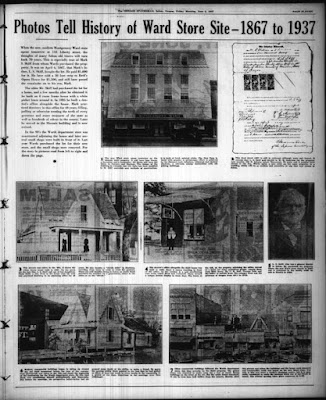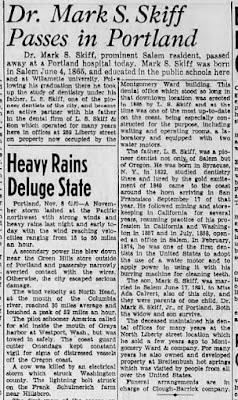Back in March of 1923 there was a Klan lecture at the Armory downtown. For an even bigger rally and parade in November, the Klan used the Fairgrounds.
The morning paper seemed pretty excited about the November event. They wrote about a
"great gathering" with a "parade of thousands." The notice was more PR
than reported news.
 |
| Oct. 21st, 1923 |
By contrast, the afternoon paper was a little skeptical, and did a basic kind of actual reporting to find out whether the Fairgrounds had actually been rented to the Klan and who was responsible for approving any rental.
 |
| October 22nd, 1923 |
Other than Mayor Giesy's appearance at a Klan banquet earlier in the year, the scope of local approval for and participation in the Klan has not been very explicit. They were a secret society, after all. But the fact that they were able to use the Armory and Fairgrounds suggests the magnitude of local government approval and general popularity.
Earlier this year, Eugene Weekly had written about an exhibit at the Lane County History Museum that extended and built on the Oregon Black Pioneers traveling exhibit, "Racing to Change." (Which just started at Salem Library this month.)
 |
| Eugene membership list, October 26th, 1922 |
They wrote:
In 1922, the Salem Capital Journal published a list of all registered Klan members in Eugene, found during a raid in Los Angeles. In Eugene, however, the story was buried by the city’s paper, whose editor had Klan ties.
As a way to confront this history, the Lane County History Museum now displays the list in its entirety — the first time it has been publicized since its original publication in the Salem newspaper. The names include such community leaders as J.H. Shelton, publisher of the Eugene Evening Guard, and C.A. Huntington, star of the 1917 University of Oregon football team that beat Penn in the third Rose Bowl, and later a UO coach.
So far no similar membership list for Salem has turned up. Still, some glimpses are visible.
 |
| April 22nd, 1931 |
In 1931 the morning paper described him as a "political practitioner of some prominence spasmodically since the days of the klan uprising back in 1921 and 1922."
That is a little ambiguous and might just be using the Klan era coincidentally and sensationally for dating purposes. This rhetoric firmly locates the Klan era, also, firmly in the past, a bygone and minor time, something successfully put down. Then, not now; them, not us.
A more contemporary note from 1923 suggests Mrs. Skiff was also a Klan leader.
 |
| Dec. 16th, 1923 |
A writer to the morning paper, responding claims about in-fighting between different Klan factions, in December of 1923 said:
...the Ladies of the Ku Klux Klan in Salem are absolutely loyal to the state organization and do not intend to brook any interference from Mrs. Mark Skiff and her following whatever.
I understand this to mean that Mrs. Mark Skiff was leading a splinter group of Klan opposed to Fred Gifford's state level leadership. It was about loyalty to one Klan leader or the other, and not about any critique of the Klan in general. If Mrs. Mark Skiff had been working to oppose the Klan, the letter's tone and detail would have been very different. Altogether this suggests the note from 1931 was saying Dr. Skiff was also active in the Klan.
 |
| May 25th, 1863 |
Mark Skiff's father was a very early dentist here, right around statehood.
 |
| Skiff House with storefronts, circa 1936 (Salem Library Historic Photos) |
He built one of the Carpenter Gothic houses (I think there were two, but this has been difficult to determine) right next to the Reed Opera House. When the Montgomery Ward building was erected, the paper featured that house with a full page spread. You can see a very similar photo at bottom right in the spread.
 |
| June 4th, 1937 |
There are a couple of other buildings around town associated with the Skiff family, but we have not remembered this part of any history. Both the Skiffs' obituaries are silent, of course. Breitenbush Hot Springs, which the Skiffs at least in part developed, has a hippie vibe today, but its origin might also exemplify extreme right-wing interests in alternative health practices. (See on Walter Huss, "Sending Spit to Ms. Safron," for a more definite Oregon example.)
 |
| November 8th, 1940 |
 |
| Oct. 11th, 1952 |
Salem dentists may have been a center for Klan activity. (Later, as a group they are a little infamous for being overrepresented among Birchers, and this might be evidence for continuity in extremism.)
Another Salem dentist group, the Utter Bros., advertised in the Klan newspaper, the Western American. This evidence too is a little uncertain and ambiguous, but there's a lot of smoke there. That paper tried to create room for plausible deniability, saying "while all of them [who advertise in the Klan paper] are not Klansmen, they are all good Americans..." But if you advertise in the Klan paper, are "friends" with the Klan paper, you have to have a certain baseline of sympathy and interest. Walks like a duck, quacks like a duck, etc.
 |
| Western American July 13th, 1923 |
 |
| Here in Salem, January 14th, 1923 |
Floyd Utter was on the Oregon Parole Board later in life, and any Klan association had not seemed to harm his career. His obituary was also silent.
 |
| March 3rd, 1981 |
The Western American also mentioned a photographer, H. M. Sanderson.
 |
| Western American, May 17th, 1923 |
 |
| January 2nd, 1922 |
Around the Election of 1922, Sanderson had also advertised with anti-Catholic propaganda.
 |
| November 7th, 1922 |
Later a group from St. Joseph's, the "civic rights association," criticized the propaganda. After the election they purchased space in the morning paper to rebut claims made in the ad of November 7th.
 |
| November 26th, 1922 |
They wrote:
No animosity; has ever been expressed by Catholics, privately or publicly, against Masons, Odd Fellows, Knights of Pythias or any, other fraternal adherents, as citizens or candidates for office, nor does any such animosity exist among them.
We think the numerous persons who were deceived by that advertisement and who were aroused to anger and prejudice by it should know the truth of the matter. It resulted in serious harm in this peaceful community. It was posted up in a certain mill-yard in this city to excite the worst passions of the workmen; it was carried to the homes in outlying districts and good men and women were thrown into a frenzy of unreasoning anger by it.
The next year Sanderson was in trouble, and the news item said he was "one of the leaders of the Ku Klux Klan in Salem."
 |
| July 19th, 1923 |
Athalie Prime wrote poems, claimed identity in the Klan, "we of the Klan...," and also alluded to the in-fighting. Otherwise there is little about Athalie.
 |
| September 15th, 1923 |
 |
| Sept. 16th, 1923 |
Finally, there is C. C. Starr, author of that note about Mrs. Mark Skiff. He has left a real trail for us. He was not a Salemite, but was very active in Salem.
 |
| Armory Dedication, 1902 (Salem Library Historic Photos, and compare in 1961) |
He first shows up in the hotel arrivals list the day of that lecture at the Armory in March To appear in the Armory implies some kind of approval and sanction from the City and local military!
 |
| March 28th, 1923 |
Salem papers did not write up any report on it, but the Klan paper did.
 |
| Western American March 29th, 1923 |
A couple of weeks later Starr showed up at the State Hospital. You may recall that the Klan saw the election of Governor Pierce as an opportunity for patronage jobs and spoils. Starr tried to dislodge the Superintendent at the State Hospital and replace him with a patronage appointment. That move didn't work.
 |
| April 11th, 1923 |
Outside of Salem they underscored Starr was pushing membership among employees, suggesting it might be a future requirement for employment.
 |
| Medford Mail Tribune, April 12th, 1923 |
A few months later Starr was more open. "I have the honor to be organizer of a secret order in Salem...sent here by order of Fred L. Gifford, grand dragon of Oregon."
 |
| August 26th, 1923 |
A little over a week later, the morning paper reported on raising funds in Salem for the WCTU Children's Home in Corvallis.
 |
| September 9th, 1923 |
In 2008 one of the buildings was successfully nominated to the National Register of Historic Places. The Nomination did not say anything about Klan fundraising. (The Klan may also not have been successful in raising or transferring the funds. That needs confirmation. A different piece called it the "fourth cottage." The Baptists were raising funds for the "fifth cottage." None of these churches or groups seemed very bothered by the company of the Klan.)
 |
| National Register Nomination |
And a couple of weeks later in September, Starr wanted "to keep you informed as to the progress and movements of the Klan in Salem." Note the saccharine "patriotism."
 |
| September 22nd, 1923 |
The details line up with Carroll Cecil Starr, whose obituary in 1963 noted that he "was widely known in fraternal organizations," but like all the other obituaries did not mention any Klan activity.
Starr's agitation at the State Hospital was not immediately successful, and over the summer a Klan-backed attempt to recall Governor Pierce, in no small part because he did not deliver enough patronage jobs to Klan members, fizzled out.
 |
| Moments in the recall attempt Sept. 6th, Sept. 20th, Oct. 9th, 1923 |
In "Some thoughts on the messed up memory culture of late 20th century America" Willamette University History Professor Seth Cotlar asks, "why did so many late 20th C. Americans feel like we had to give a pass to historical figures who committed their lives to undermining the foundational values we claimed the US stood for?"
He is researching and writing mostly about the second half of the 20th century, but the same holds true for the way our establishment history of Salem has given a pass to and erased the activity and popularity here of the second Klan in the early 1920s.
Previously here:
- "100 Years ago The Birth of a Nation "took Salem by Storm" (2016)
- With evidence of Klan harassment, "Policing Racial Boundaries in 1920s: Herman Hayes, D. H. Brown, and Charlie Maxwell" (2021)
- On increasing acceptance, "Between 1921 and 1923 Salemites Seemed to Shift Radically on the Triple K" (2021) and "George Putnam and the Afternoon Paper's Seeming Shift on the 1923 Legislature" (2023)
- With more on the Federation of Patriotic Societies, "Reassessing Asahel Bush and the 1922 Election: Our Problematic Legacies" (2022)
- Actual funny business in, "Recount and Fraud in the 1922 Primary Election for Governor" (2022)
- On our own Mayor, "Mayor Giesy attends Klan Dinner in 1923" (2023)
- And a complication. Even in the face of proto-fascist anti-Catholic politics and sentiment here, straight-up fascism in Europe appealed to some Catholics: "The Appeal of a Strong Man: Mussolini and the Fascists Praised in 1923" (2023)
- "Sunday History Column on Anti-Catholic Legislation points to Much More" (2023)
- "Oregon Electric Klan Special to Corvallis Stops in Salem in 1923" (2023)


No comments:
Post a Comment